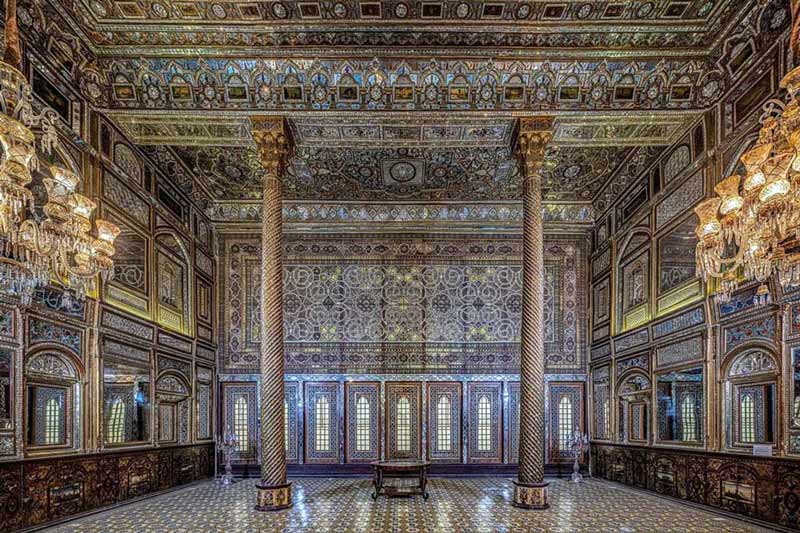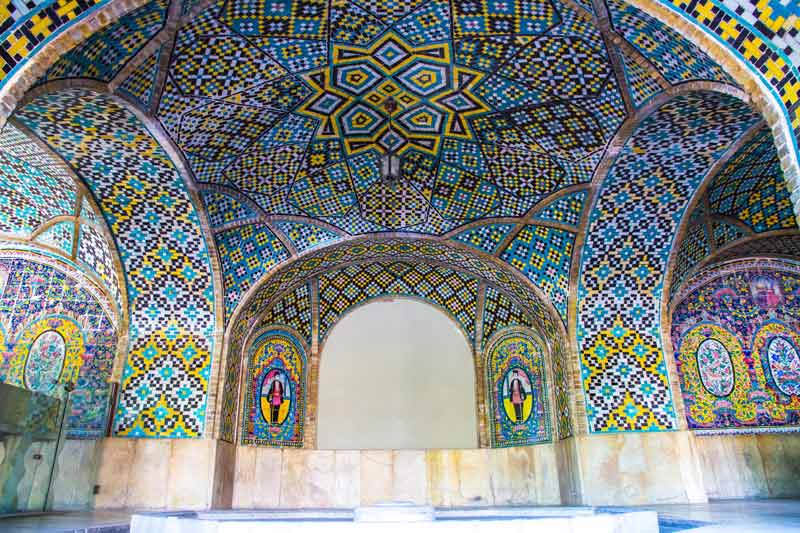Golestan Palace: A Timeless Symbol of Persian Grandeur
Do you like to step into a world of Persian grandeur and opulence? Look no further than Golestan Palace, the stunning palace complex located in the heart of Tehran. With its exquisite architecture, intricate design, and rich cultural heritage, Golestan Palace is a testament to the artistic and cultural traditions of Iran. But what sets this palace complex apart from other historical sites around the world?
Being one of the oldest and most iconic buildings in the city, the Golestan Palace complex was inscribed on the UNESCO World Heritage List in 2013 and is considered to be one of the most important cultural landmarks in Iran. In addition to its cultural and historical significance, Golestan Palace is also a popular destination for photographers and artists, who are drawn to its stunning beauty and intricate design.
To visit Golestan Palace, don’t hesitate to look into our Iran World Heritage Tour.

The Palace Through History
The history of the Golestan Palace dates back to the Safavid era when it was initially constructed as a royal residence for the rulers of the Safavid dynasty. Over the centuries, the palace complex was expanded and renovated by subsequent rulers, including the Qajar dynasty, who transformed it into a magnificent palace complex that would serve as the seat of the royal court and the center of political power in Iran.

Architecture and Design
While other palaces in Tehran such as Saadabad Palace or Niavaran Palace also boast beautiful architecture and historical significance, Golestan Palace stands out for its unique combination of Persian, European, and Russian styles, that have played a role in the country’s history. The stunning artwork and intricate design of the palace complex reflect the artistic and architectural traditions of Iran. The palace complex consists of a series of buildings, halls, and courtyards that are adorned with intricate tilework, frescoes, and stained glass windows:
- Sun Building: The most famous building in the palace complex is the Shams-ol-Emareh, or “Sun Building,” which was built by Naser al-Din Shah in the late 19th century. The building is a masterpiece of Persian architecture, with its distinctive combination of traditional Iranian design elements and European architectural styles. The building has two floors, with the upper floor featuring a stunning domed hall that offers panoramic views of the city.
- Hall of Mirrors: Another notable building in the palace complex is the Hall of Mirrors, which is adorned with exquisite mirrorwork and intricate tilework. The hall was used for official receptions and ceremonies and is considered to be one of the most beautiful halls in the palace complex.
- Other Structures in Golestan Palace: The palace complex also includes a number of other buildings and structures, including the Marble Throne Hall, the Diamond Hall, and the Museum of Gifts. Each of these buildings is a stunning example of Persian architecture and design, and is adorned with exquisite artwork and decorative elements.

Why is Golestan Palace in Iran recognized as a UNESCO world heritage?
Golestan Palace is a masterpiece of Persian architecture and design and for some specific reasons it is registered as a World Heritage:
- Golestan Palace complex exhibits an important interchange of human values.
- Golestan Palace complex bears a unique testimony to a cultural tradition that has spanned centuries.
- Golestan Palace complex is an outstanding example of a type of building ensemble that illustrates a significant stage in human history.
- Golestan Palace complex is an outstanding example of a traditional human settlement that represents a culture that has stood the test of time.
- The Golestan Palace complex is directly associated with events, ideas, and artistic works of outstanding universal significance that continue to inspire visitors from around the world.

When to visit Golestan Palace?
The best time to visit Golestan Palace in Tehran, Iran is during the spring (March to May) and fall (September to November) seasons, when the weather is mild and pleasant. During these seasons, temperatures typically range from 15-25°C (59-77°F). Summer (June to August) in Tehran can be hot, with temperatures reaching up to 40°C (104°F), while winter (December to February) can be cold and rainy, with temperatures ranging from 0-10°C (32-50°F). However, visitors can still enjoy the palace’s stunning architecture and beautiful surroundings regardless of the season, so it ultimately depends on personal preference and travel plans.

Where is the Golestan Palace located?
The Golestan Palace complex is situated in the heart of Tehran’s old town, near the Grand Bazaar and other historical landmarks. The address of Golestan Palace is as follows: Panzdah-e-Khordad St, Tehran, Iran. The palace complex is easily accessible by public transportation, including metro and bus, and is a popular destination for both domestic and international visitors to Iran.
What to visit in Iran after Golestan Palace?
We have included Golestan Palace in almost all Iran cultural tours & Iran Budget Tours, and especially on Iran World Heritage Tour. These packages offer a unique opportunity to explore the rich cultural and historical heritage of the region. Whether you are interested in exploring the region’s World Heritage sites, our tour packages offer a comprehensive and immersive experience of Iran’s diverse cultural and religious traditions at reasonable rates.
If you’re interested in exploring more of Iran’s cultural and historical treasures, there are many other destinations worth visiting. Here are a few suggestions:
Tehran: The capital city of Iran is a vibrant metropolis with many cultural and historical attractions, including the National Museum of Iran, and the Shahyad Tower.
Kashan: This historic city is home to some of Iran’s most beautiful traditional houses, as well as the stunning Fin Garden and the Agha Bozorg Mosque.
Yazd: This desert city is famous for its unique architecture and historical sites, including the Jameh Mosque and the Zoroastrian Fire Temple.
Persepolis: Located in the southwestern province of Fars, Persepolis is an ancient city that was once the capital of the Achaemenid Empire. The city is home to stunning ruins, including the Gate of All Nations, the Apadana Palace, and the Hall of 100 Columns.
Isfahan: Known as the “half of the world,” Isfahan is a beautiful city with a rich history and stunning architecture. Highlights include the Naqsh-e Jahan Square, the Chehel Sotoun Palace, and the Shah Mosque.
Shiraz: Located in the southern province of Fars, Shiraz is known for its beautiful gardens, historic mosques, and vibrant bazaars. Highlights include the gardens of Eram and Narenjestan, the Vakil Mosque, and the Nasir al-Mulk Mosque.
Ahvaz: Located in the southwestern province of Khuzestan, Ahvaz is a city known for its rich history and culture. Highlights include the Shush, Shushtar Historical Hydraulic System, and the ancient Elamite complex of Chogha Zanbil.
Let us know your experiences of visiting or your questions about the Golestan Palace in the comment box below, we will be happy to hear from you!





Leave A Comment